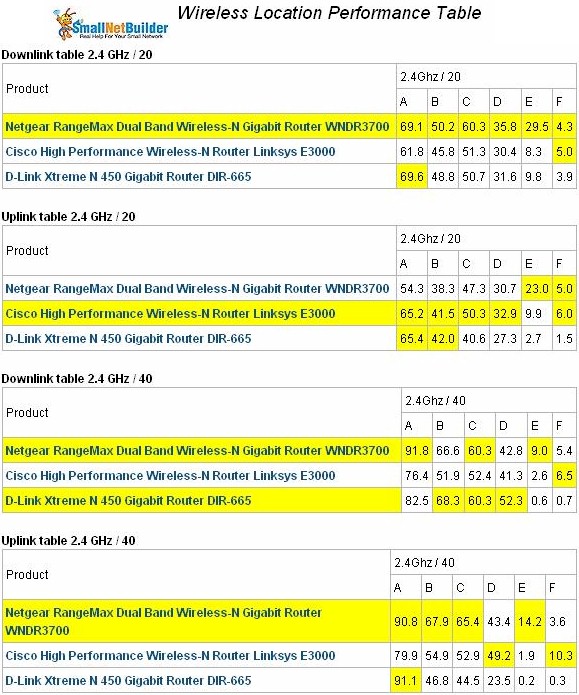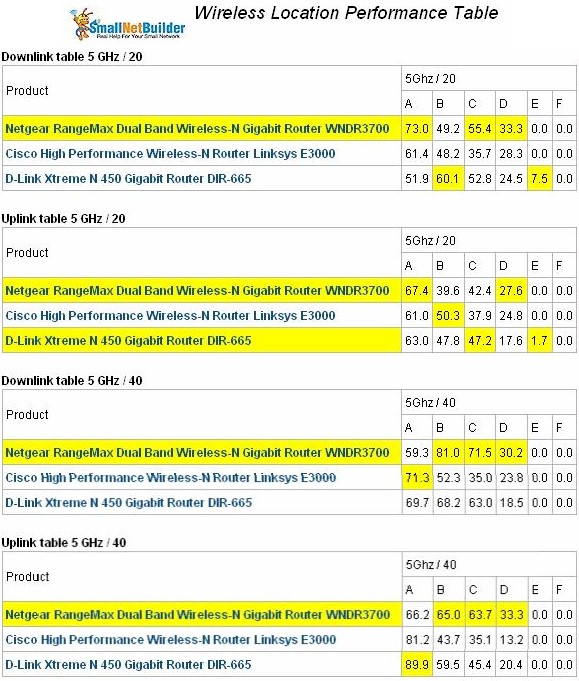The D-Link DIR-665 Xtreme N 450 Gigabit Router has been added to the Wireless Charts.
As promised in the First Test review, I put D-Link’s DIR-665 through our six location performance test using our standard 802.11n dual-stream Intel WiFi Link 5300 client. Tests were run using the 5300 with only the two antennas built into the Dell Mini 12 test netbook, so the results are for a two-stream N client connecting to a three-stream N router. I should note that Intel again updated its drivers for the 5300, so I used the Win XP 13.2.1.5 driver for the tests.
I won’t be running the multi-location performance tests with a three-stream client anytime soon. The only ones available come in newer notebooks and, given the dearth of three-stream routers (and the fact that they have underwhelmed with their performance), that’s an investment not worth making at this point. Of course, if someone would like to provide a long term loan of a three-stream N notebook, I’d be happy to use it for three-stream router testing.
I covered the 665’s other details in the original review, so let’s jump right to the wireless performance results.
I generated 2.4 GHz and 5 GHz Wireless Performance tables for the DIR-665 and two of the best-selling dual-stream 802.11n routers, the NETGEAR WNDR3700 and Cisco Linksys E3000. Yes, the NETGEAR and Cisco are simultaneous (dual-radio) dual-band routers, while the 665 has only a single radio. But since the 665’s $200 price is $50 – $60 higher than either of the other routers, I think it’s a fair comparison.
A scan of the 2.4 GHz table below doesn’t reveal any particular advantage for the DIR-665 vs. these two competitors. The 665’s best case unidirectional 2.4 GHz throughput of 91 Mbps (40 MHz mode, uplink), was matched by the WNDR3700. In three out of four test runs, the WNDR3700 either won or tied with the 665.

D-Link DIR-665 wireless performance comparison – 2.4 GHz
The 5 GHz table reveals the only good news about the DIR-665’s performance—it’s the only router I’ve tested to date to successfully complete testing in one of my weak signal dead zones (Location E) in the 5 GHz band.
The feat was accomplished with the router set to use 20 MHz bandwidth mode only. When I switched the DIR-655 over to Auto 20/40 MHz mode, the test netbook couldn’t even see it anymore.
Despite the 665’s Location E advantage, the WNDR3700 turned in signficantly higher throughput in the medium signal test locations C and D using the 5 GHz band. Highest throughput for the DIR-655 was 89.9 Mbps, again running uplink in 40 MHz mode.

D-Link DIR-665 wireless performance comparison – 5 GHz
Here are links to the IxChariot wireless test plots if you’d like to explore further:
- 2.4 GHz / 20 MHz downlink
- 2.4 GHz / 20 MHz uplink
- 2.4 GHz / 20 MHz up and downlink
- 2.4 GHz / 40 MHz downlink
- 2.4 GHz / 40 MHz uplink
- 2.4 GHz / 40 MHz up and downlink
- 5 GHz / 20 MHz downlink
- 5 GHz / 20 MHz uplink
- 5 GHz / 20 MHz up and downlink
- 5 GHz / 40 MHz downlink
- 5 GHz / 40 MHz uplink
- 5 GHz / 40 MHz up and downlink
If you check the 40MHz mode up and downlink plots you’ll see a total throughput of 121 Mbps in 2.4 GHz and 129 Mbps in 5 GHz. So it appears that more bandwidth is available if you run multiple simultaneous connections, a plus for busy multi-user WLANs.
The conclusion at the end of the First Test review was that it seemed a three-stream N router might offer improved performance when used with dual-stream clients. But after running the full set of location performance tests, it appears that any advantage doesn’t hold up as signals drop.
My bottom line is that there doesn’t appear to be any practical advantage to buying a three-stream N router at this point if you don’t have three-stream clients. I’d wait at least until three-stream bridges are available so that any higher throughput that three-stream N provides can be applied on a wider basis.
But don’t hold your breath hoping that "450 Mbps" N is going to solve your video streaming woes. From what I’ve seen so far, three-stream throughput stability is no better and possibly worse than two-stream.
